- 1Key Laboratory of Deep Oil and Gas, China University of Petroleum (East China), Qingdao, China
- 2Laboratory for Marine Mineral Resources, Qingdao National Laboratory for Marine Science and Technology, Qingdao, China
- 3Institute of Oceanographic Instrumentation, Qilu University of Technology (Shandong Academy of Sciences), Qingdao, China
- 4School of Ocean Technology Sciences, Qilu University of Technology (Shandong Academy of Sciences), Qingdao, China
- 5School of Earth Sciences and Engineering, Sun Yat-sen University, Guangzhou, China
The scalar images (PP and PS) can be effectively obtained in vector-based elastic reverse time migration by applying dot product–based scalar imaging conditions to the separated vector wavefields. However, the PP image suffers from polarity reversal issues when opening angles are greater than
Introduction
Reverse time migration (RTM) is a seismic data processing method for migrating seismic reflection data to obtain subsurface images that effectively describe geological structures (Baysal et al., 1983; McMechan, 1983; Whitmore, 1983). Multicomponent seismic data processing techniques have been evolved with seismic acquisition techniques and high-performance computing technologies to acquire more precise images. Elastic reverse time migration (elastic RTM) is one of the most reliable multicomponent seismic data imaging techniques that can provide surface PP and PS reflection information using P-wave and S-wave reflection data. Unlike acoustic RTM, which analyzes P-wave propagation in the subsurface medium, elastic RTM integrates elastic P-wave and S-wave propagation with wave conversion. As a result, the wave conversion-related elastic response and vector-based propagation characteristics are more accurate than the acoustic approximation.
Like acoustic RTM, the early elastic RTM (Sun and McMechan, 1986) used elastic wave equation to forward and backward extrapolation wavefields and extract images by cross-correlation imaging conditions for Cartesian components. For these images, the migration results of different modes are intermixed together. The interference would result in crosstalks in final images and make it difficult to highlight the advantages of S-wave information. The S-wave information can be further used to supplement P-wave images in imaging targets with poor PP reflectivity or under gas clouds. Therefore, in addition to applying wavefield extrapolation and imaging conditions, a more suitable approach for elastic RTM to obtain decoupled elastic wavefield is wavefield separation. Early attempts of wavefield separation use divergence and curl operators. The P wave separated by a divergence operator is usually represented by a scalar-based wavefield, and the S wave separated by a curl operator is usually represented by a scalar-based wavefield in a 2D case or a vector-based wavefield in a 3D case. Their amplitude and phase are different from the original elastic wavefield. Recently, the decoupled wave equation approach has been proposed. The decoupled wave equations (Ma and Zhu, 2003; Li, 2007; Wang and McMechan, 2015; Du et al., 2017) have been proposed to decouple the wavefields of displacement or particle velocity. Zhu (2017) has used Helmholtz decomposition and vector Poisson’s equation to decompose P- and S-mode wavefields with correct phases, amplitudes, and physical units similar to the decoupled wave equation. Furthermore, the decoupled wave equation with the assumption of heterogeneous medium (Elita Li et al., 2018; Tang and McMechan, 2018) has also been proposed to handle the wavefield coupling problem at interfaces. The separated P wave and S wave are represented by vector-based wavefields and have the same amplitude and phase as the original elastic wavefield. Therefore, we apply the decoupled wave equations to construct the decoupled source and receiver wavefields.
In addition to wavefield separation, imaging conditions are also the key ingredient for the elastic RTM algorithm to determine the accuracy and quality of imaging results. According to different wavefield separation methods and wavefield representations, imaging conditions are also different. As for scalar-based P wave and vector-based S wave based on divergence and curl operators, various imaging conditions include cross-correlation imaging conditions or divergence- and curl-based imaging conditions (Yan and Sava, 2008; Du et al., 2014). As a result, the migrated PP image may encounter backscattering artifacts whose opening angle is near
Furthermore, the S wave’s polarization by Poynting vector (Du et al., 2013) or the modified imaging condition (Duan and Sava, 2015) can correct the polarity reversal problem to a certain degree. As for the vector-based P wave and S wave by the decoupled wave equation, the scalar PP and PS images are required to facilitate further interpretation. There are some imaging conditions, such as the cross-correlation imaging condition of Cartesian components (Claerbout, 1971), the scalar imaging condition (Wang and McMechan, 2015; Du et al., 2017; Zhu, 2017; Yang et al., 2018), and energy cross-correlation imaging condition (Rocha et al., 2016). The cross-correlation imaging condition of Cartesian components generates multiple imaging results for interpretation, while the energy cross-correlation imaging condition only generates one image of elastic energy, which misses some important convert-wave information. Therefore, the dot product–based scalar imaging conditions, extended from cross-correlation imaging conditions and sum up these cross-correlation images of Cartesian components together, have been used to obtain the final scalar images (PP and PS).
The scalar imaging condition can output scalar images (PP and PS) of vector wavefields but an encounter with polarity reversal problem and backscattering artifacts in PP images. Different from the polarity reversal in the PS image in which P wave and S wave are separated by divergence and curl operators, the polarity reversal problem is introduced to PP images by scalar imaging conditions while the opening angle exceeds
In this article, based on the analysis of the Laplace filter in the vector-based scalar image, we select the parallel-oriented partial derivatives and abandon normal-oriented partial derivatives of the Cartesian component’s cross-correlation results to propose the pseudo-Laplace filter and produce an optimized image. Theoretical analysis with the plane wave assumption is then carried out to show that the PP image with a pseudo-Laplace filter succeeds in backscattering attenuation and polarity correction. Finally, the numerical experiments prove that the pseudo-Laplace filter can guarantee its stability and practicability without increasing additional computation burdens.
Methodology
The vector-based elastic RTM algorithms are as follows: 1) forward extrapolated decoupled source wavefields using the decoupled wave equation and retaining their boundary values at imaging time points; 2) back extrapolated decoupled receiver wavefields using the decoupled wave equation and reconstructing the source wavefields by the retained boundary values at the same imaging time point; 3) applying scalar imaging conditions to construct scalar imaging results (PP and PS). Here, we analyze the scalar imaging condition based on the decoupled wave equation and apply it using a Laplace filter or pseudo-Laplace filter.
The Decoupled Wave Equation
In a homogeneous and isotropic medium, the elastic wave extrapolation (Aki and Richards, 1980) can be expressed as follows:
where
Decoupled Equation 2 is embedded in the update of the displacement wavefield. The P and S wavefields are constructed by the first two equations, respectively, and their summation can obtain the total elastic wavefield in the third equation (Ma and Zhu, 2003; Li, 2007; Zhu, 2017). In contrast to the summing of decoupled P wavefield and S wavefield, the decoupled S wavefield can be constructed by subtracting the P wavefield from the total elastic wavefield. Decoupled Equation 2 produces displacement vector wavefields of pure P- and S-waves. Correspondingly, the first-order stress-particle velocity wave equation has been proposed (Li, 2007; Du et al., 2017; Zhou et al., 2018):
where
The Scalar Imaging Condition for the PP Mode
For the decoupled vector wavefields, we obtain scalar imaging results by imaging conditions, including cross-correlation imaging condition of Cartesian components generating too many results to interpret, and dot product–based scalar imaging conditions. Regardless of source normalization, the dot product–based scalar imaging condition (Du et al., 2017; Zhu, 2017; Yang et al., 2018) for the PP wave can be written as follows:
in terms of source particle velocity vector
Algebraically, the dot product is the sum of some related Cartesian components products, which means
By introducing the opening angle
Here,
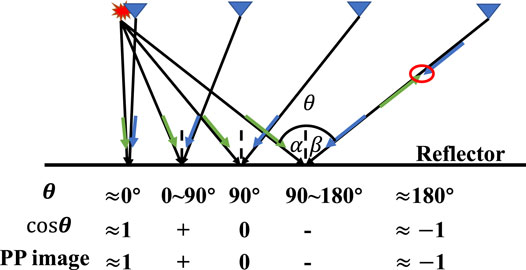
FIGURE 1. Sign distributions of PP images via the opening angles. The green arrows and blue arrows represent the P-wave incident vectors of the source wavefield and the reflected vectors of the receiver wavefield, respectively. Regardless of the incident and reflected vector’s modulus, the amplitude of PP images by the dot product scalar imaging condition implicitly depends on the scaling factor
The Scalar Imaging Condition With the Laplace Filter
In acoustic RTM or scalar-based elastic RTM, the Laplace filter (Youn and Zhou, 2001) has been used to suppress the backscattering artifacts in the PP image. As for the PP image in vector-based elastic RTM, the scalar imaging condition with a Laplace filter can be expressed as follows:
Here,
Here,
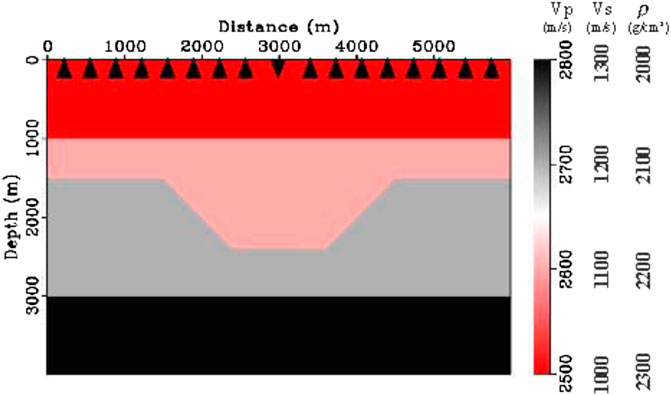
FIGURE 2. The P-wave velocity, S-wave velocity, and density of a fault model. The model contains 600 points of
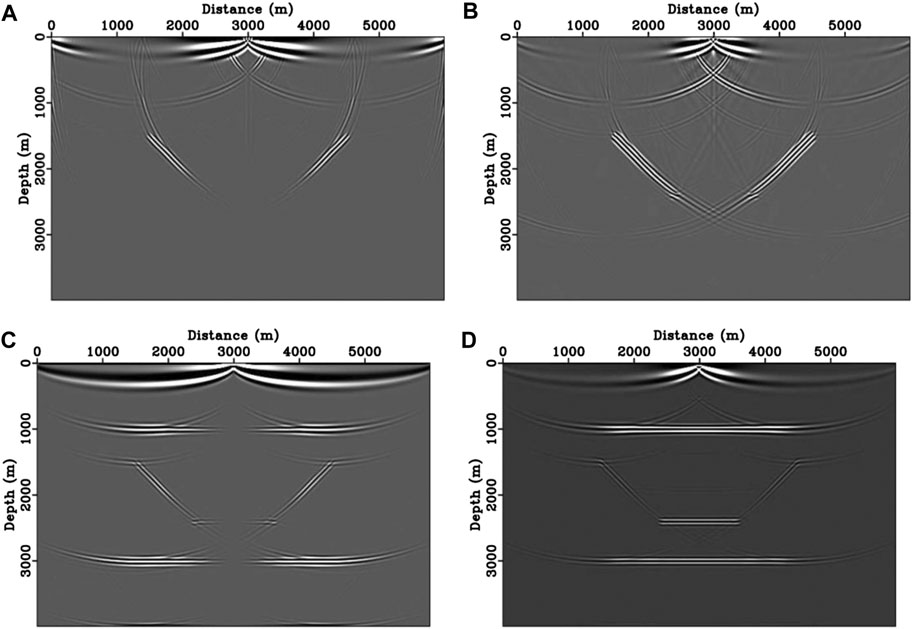
FIGURE 3. The decoupled migrated images of
Backscattering noise has been suppressed in all decoupled images. Moreover, these decoupled images have different migration capabilities. On the one hand, the decoupled items
The Scalar Imaging Condition With the Pseudo-Laplace Filter
Since normal-oriented partial derivative related items of the Laplace filter are greatly affected by crosstalk noise, the horizontal derivative related decoupled items have been selected to migrate the PP image. Analogous to the scalar imaging condition with the Laplace filter, we propose the scalar imaging condition with the pseudo-Laplace filter. To characterize the scalar imaging condition with a pseudo-Laplace filter mathematically, we first define the pseudo-Laplace operator
and the PP wave’s Hadamard product image
where
Combining the pseudo-Laplace operator with the PP wave Hadamard product image vector, we propose a scalar imaging condition with a pseudo-Laplace filter for vector-based wavefields as follows:
Here,
The scalar imaging conditions with a Laplace filter (Eq. 4) and a pseudo-Laplace filter (Eq. 8) depend on second-order partial derivatives of Cartesian components cross-correlation results. Different from the Laplace filter composed of parallel-oriented and normal-oriented items, only the parallel-oriented items are selected to form the pseudo-Laplace filter. As shown in Figure 4, we migrate the PP images of the fault model by the scalar imaging condition with the Laplace filter and with the pseudo-Laplace filter. Figure 4A is the migrated PP scalar image with a Laplace filter, the sum of Figures 3A–D. Similarly, the sum of Figures 3A,D is just one scalar migrated PP image with a pseudo-Laplace filter, as shown in Figure 4B. Compared with the PP image with a Laplace filter (Figure 4A), backscattering noise suppression (marked by red arrows) and polarity reversal correction (marked by red circles) have been shown in the PP image with a pseudo-Laplace filter (Figure 4B).
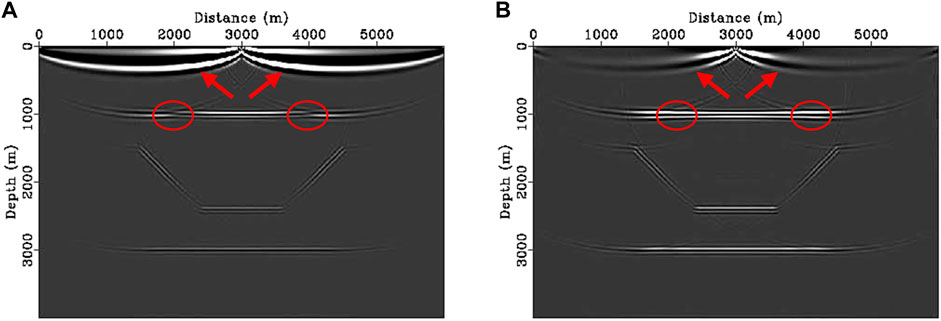
FIGURE 4. PP images by the scalar imaging condition with a Laplace filter (A) and with a pseudo-Laplace filter (B). Compared with the PP image with a Laplace filter (Panel A), backscattering noise suppression (marked by red arrows) and polarity reversal correction (marked by red circles) have been shown in the PP image with a pseudo-Laplace filter (Panel B).
For the application in elastic RTM, we should migrate three Cartesian component’s images (or two images in a 2D case) by time integration and then sum second-order derivatives of three images together. Compared with the scalar imaging condition, additional storage of three Cartesian component’s images and computation of second-order derivative operation are introduced in scalar imaging conditions with a pseudo-Laplace filter. Compared with the storage and computation costs consumed by the wavefield extrapolation of elastic RTM, the additional calculation introduced by the proposed filter can be ignored to a certain degree. Thus, the scalar imaging condition with a pseudo-Laplace filter is easy to perform and does not require additional processing or storage, which is essential for elastic RTM.
Backscattering Attenuation and Polarity Correction
Based on the above-tested fault model, the suppression of backscattering and correction of polarity reversal have been shown in the PP scalar image with the proposed pseudo-Laplace filter. The section will theoretically illustrate how the pseudo-Laplace filter suppresses backscattering noise and correct polarity reversal in PP images with the assumption of a plane wave.
For the vector-based elastic wavefields, the source-side particle velocity vector
and
Here,
Substituting the plane wave definitions (Eq. 12) into Eqs 4, 7, 11, we obtain an expression with the assumption of the plane wave as follows:
and
In the 2D case of incident pure P wave, the reflected P wave without wave conversion would be obtained in an observation coordinate system along the horizontal surface and vertical depth. As shown in Figure 5A, the geological structure information of the reflector has been introduced in the descriptions of particle velocity vectors in the observation coordinate system. A local coordinate system (as shown in Figure 5B) is constructed along with tangential and vertical directions of the reflector to simplify the representation of vectors in the source and receiver wavefield. As for pure P wave, the polarization vector
and
Unlike source wavefield, the pure P wave in receiver wavefield should be described by conjugation of a reflected vector
and
According to the descriptions of incident vector (Eq. 14) and conjugation of reflected vector (Eq. 15), we can rewrite the scalar imaging condition, the scalar imaging condition with a Laplace filter, and the scalar imaging condition with a pseudo-Laplace filter in the local Cartesian coordinate system as follows:
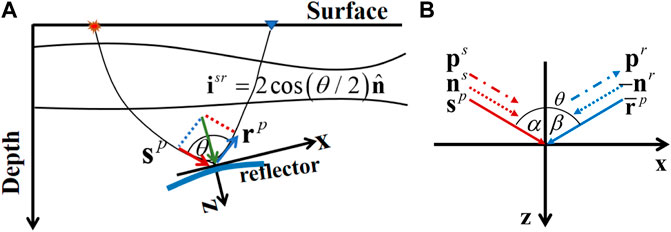
FIGURE 5. The incident vector and reflected vector of pure P wave in observation coordinate system (A) and local coordinate system (B). The coordinate observation system is constructed along the horizontal surface and vertical depth. The illumination vector
and
Here,
Otherwise, the amplitude-related items in
and
Here,
The variation of the weighting factor for the opening angle
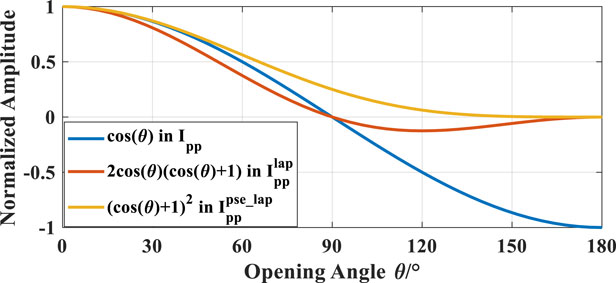
FIGURE 6. The variation of a weighting factor in the scalar imaging condition, the scalar imaging condition with a Laplace filter and with a pseudo-Laplace filter. Note that the blue curve of the weighting factor
Numerical Examples
This section presents a two-layer flat model and a four-layer inclined model to demonstrate the challenges of backscattering noise and polarity reversal in PP images caused by scalar imaging conditions. Moreover, it shows how to suppress them by the pseudo-Laplace filter. Then, using numerical values, we investigate the amplitude variation versus the opening angle to demonstrate the consistency of the pseudo-Laplace filter. The Marmousi 2 model (Martin et al., 2006) is then used to demonstrate the effectiveness and advantages of the pseudo-Laplace filter in the suppression of backscattering artifacts and correction of polarity reversal.
When it comes to vector-based elastic RTM, the decoupled elastic wave equation (Xiao and Leaney, 2010; Du et al., 2017) generates source and receiver wavefield of decoupled P wave. Furthermore, the source normalization by decoupled P-wave source wavefield should be introduced to balance the energy between the shallow and deep layers.
The Two-Layer Flat Model
The two-layer flat model shown in Figure 7 is
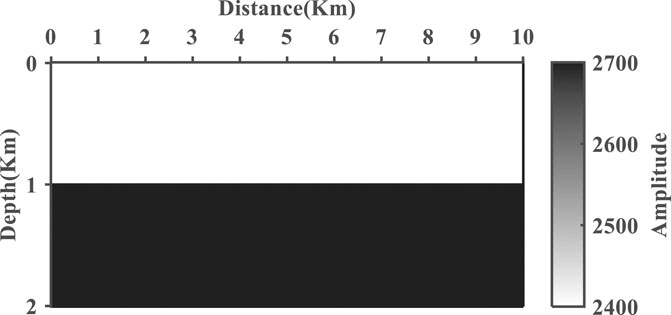
FIGURE 7. The P-wave velocity of the two-layer flat model, whose S-wave velocity and density are satisfied with
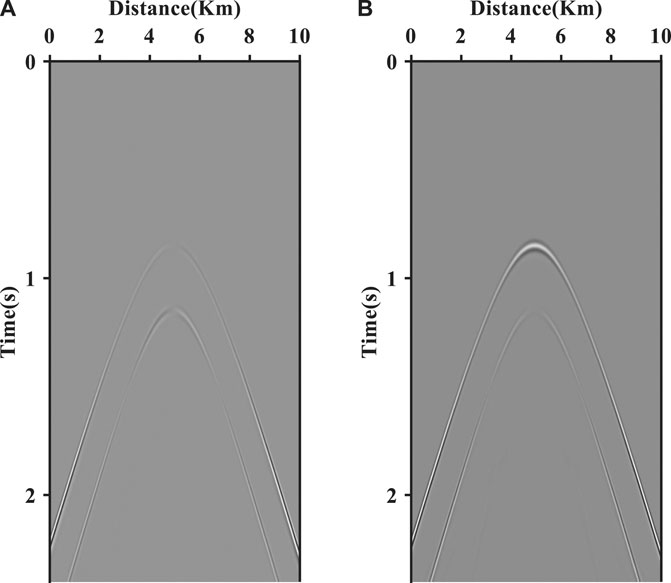
FIGURE 8. The synthetic multicomponent seismic record without direct wave: (A) x-component and (B) z-component.
The migrated PP images by scalar imaging conditions, scalar imaging conditions with a Laplace filter, and scalar imaging conditions with a pseudo-Laplace filter are shown in Figure 9. It is evident that backscattering artifacts (marked by the red arrow) influence the PP image by the scalar imaging condition (shown in Figure 9A) and have been attenuated effectively in the PP image with the application of a Laplace filter (shown in Figure 9B) and with a pseudo-Laplace filter (shown in Figure 9C). Apart from backscattering noise, the other noise, such as polarity reversal, also occurs at the interface. As for the interface of 1 km depth, the maximum incident angle reaches
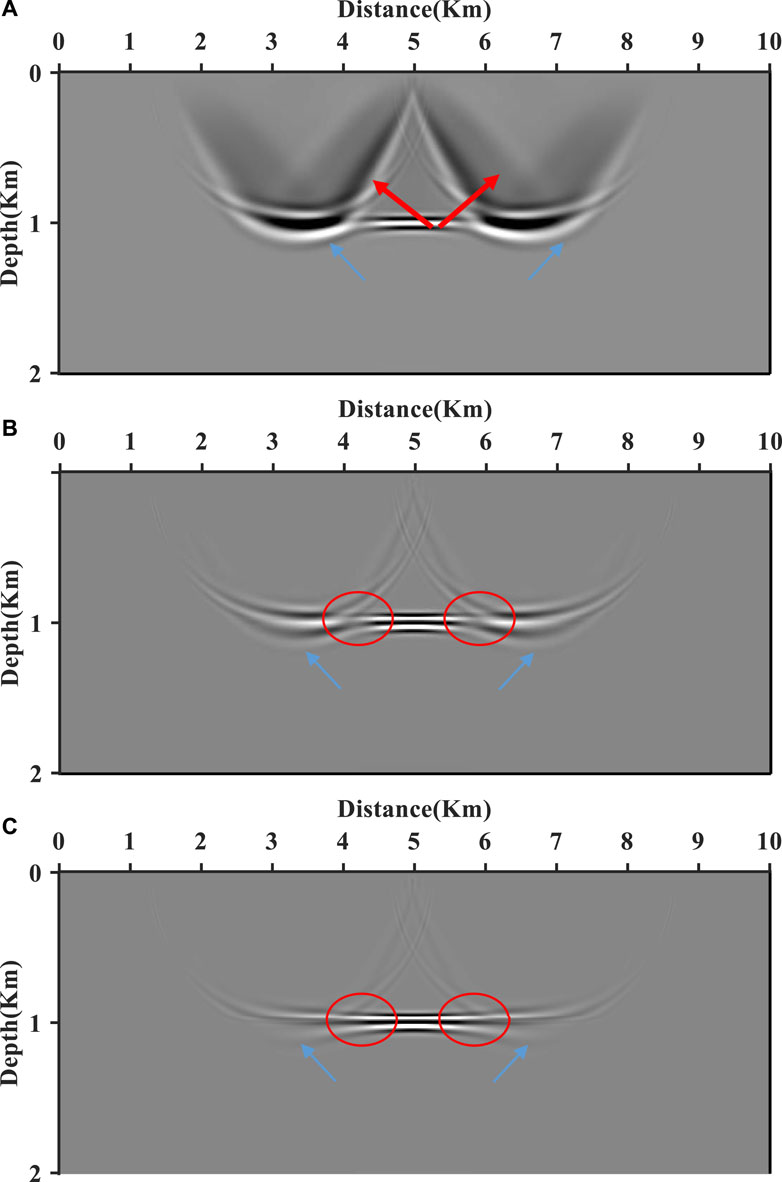
FIGURE 9. PP migrated images of the two-layer flat model by the scalar imaging condition (A), the scalar imaging condition with a Laplace filter (B), and the scalar imaging condition with a pseudo-Laplace filter (C). The backscattering noise (marked by the red arrow) has been effectively suppressed in PP images by scalar imaging conditions with a Laplace filter and a pseudo-Laplace filter. Furthermore, the polarity reversal (marked by the red circle) has been corrected in the PP image by the scalar imaging condition with a pseudo-Laplace filter.
Additionally, we measure the amplitudes of these images at the interface at a depth of 1 km and convert the offset variable to the opening angle variable using geological and elastic parameters. Then, we compare these amplitudes (blue curves) from Figure 9 with the theoretical reflection coefficient
What is more, the extracted amplitudes have higher values than the corresponding weighting theoretical reflection coefficient at large angles of incidence and then decline to zero due to the limited acquisition space. Both Laplace and pseudo-Laplace filters would fail to maintain the amplitude of images at large incidence. Figure 10A shows the extracted amplitudes from Figure 9A and weighting theoretical reflection coefficient
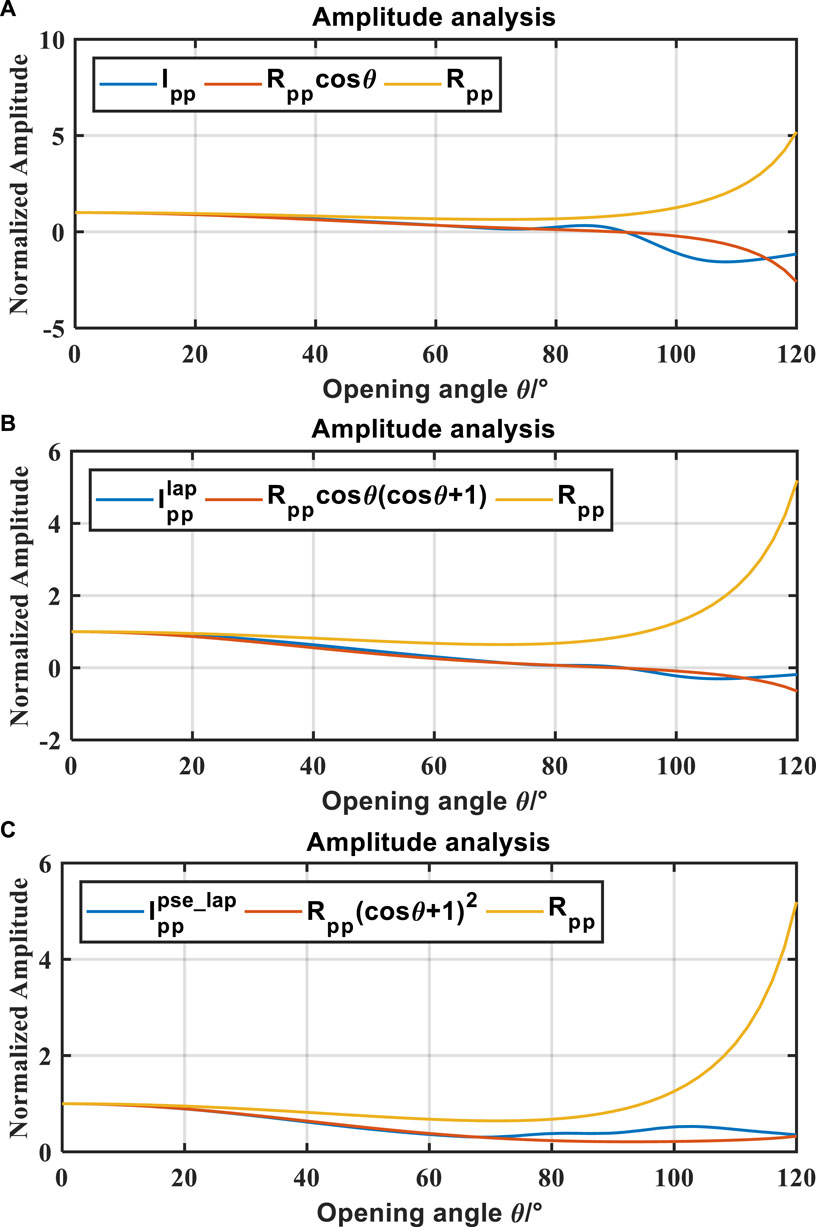
FIGURE 10. The comparison between the analytical reflection coefficient
The Four-Layer Inclined Model
The four-layer inclined model, as shown in Figure 11, is
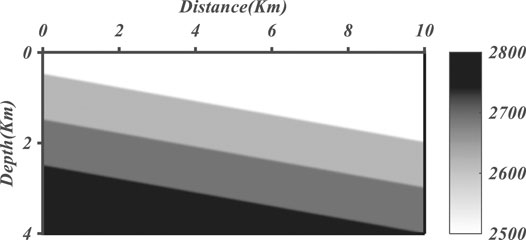
FIGURE 11. The P-wave velocity of the four-layer inclined model, whose S-wave velocity and density are satisfied with
The migrated PP images by scalar imaging conditions with a Laplace filter and scalar imaging conditions with a pseudo-Laplace filter are shown in Figure 12. It is evident that backscattering artifacts (marked by the red arrow) influence the PP image by scalar imaging conditions (shown in Figure 12A) and have been attenuated effectively in the PP image with the application of a Laplace filter (shown in Figure 12B) and with a pseudo-Laplace filter (shown in Figure 12C). Apart from backscattering noise, the other noise, such as polarity reversal, also occurs at images along with the interfaces. As for the first interface, the maximum incident angle reaches
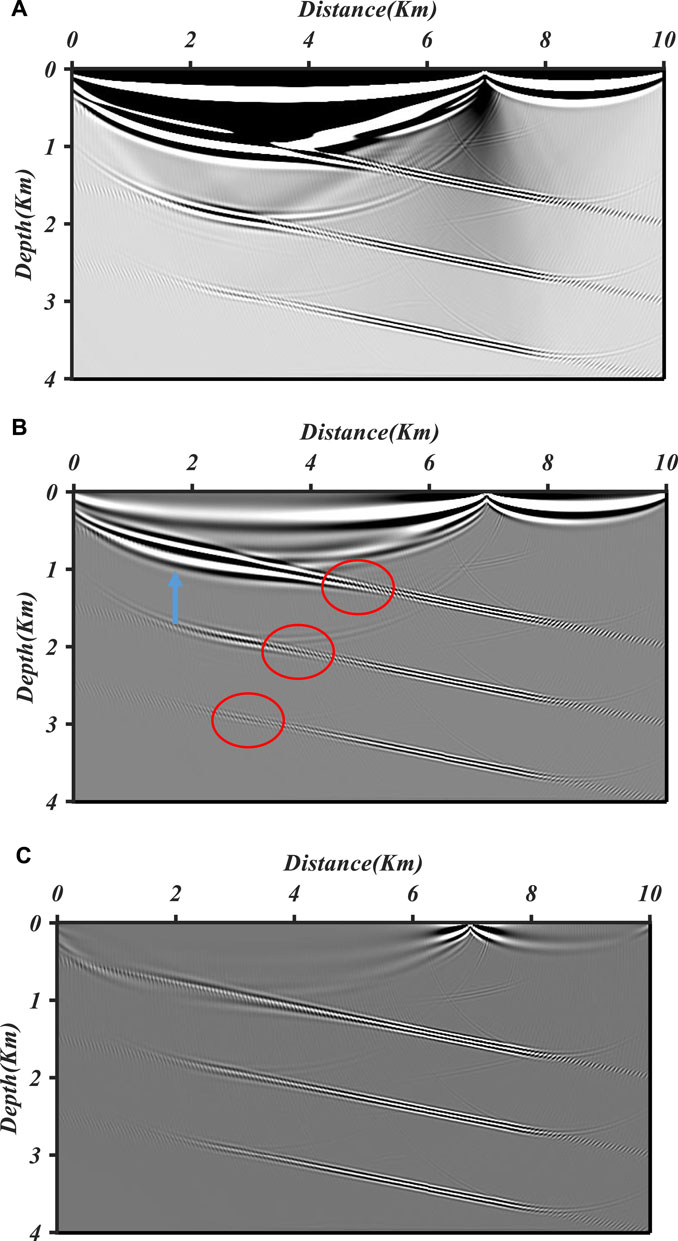
FIGURE 12. PP migrated images of the four-layer inclined model by the scalar imaging condition (A), the scalar imaging condition with a Laplace filter (B), and the scalar imaging condition with a pseudo-Laplace filter (C). The backscattering noise (marked by the red arrow) has been effectively suppressed in PP images by scalar imaging conditions with a Laplace filter and a pseudo-Laplace filter. Furthermore, the polarity reversal (marked by the red circle) has been corrected in the PP image by the scalar imaging condition with a pseudo-Laplace filter.
To analyze the amplitude variation versus opening angle, we pick up the max amplitude of these images along the second interface and convert the offset variable to the opening angle variable with a geological structure. Since the first interface is affected by the direct wave and heterogeneous wave such as refracted wave, the second interface has been utilized. Once the amplitude variation has been picked up, the smoothing and normalization are required to avoid interference of other factors such as phase. As shown in Figure 13, the variations of normalized amplitude in three images match the variations of normalized weighting with an opening angle ranging from 0 to near
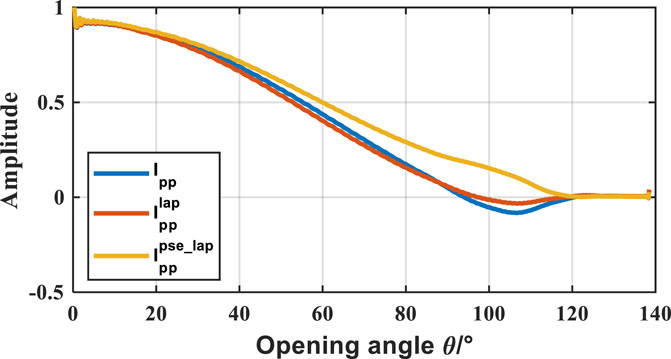
FIGURE 13. The variation of normalized amplitude in PP images with the opening angle. Numerically, amplitude symbols change with the P-wave incident angle reaching
Marmousi 2 Model
The Marmousi 2 model is used in this example to show how the pseudo-Laplace filter can effectively suppress backscattering noise, resolve polarity reversal, and generate a high-quality PP image in complex geological structures.
As shown in Figure 14, the modified Marmousi 2 model (Martin et al., 2006) contains 1325 points in the horizontal direction with 10 m sample interval and 934 points in the vertical direction with 5 m sample interval. Thus, the size of the Marmousi 2 model is

FIGURE 14. The P-wave velocity of the elastic Marmousi 2 model (A) and the S-wave velocity of the elastic Marmousi 2 model (B) and the density is constant of 1 g/cm3.
Figure 15A is the migrated PP image by the scalar imaging condition with the Laplace filter, and Figure 15B is the migrated PP image by the scalar imaging condition with a pseudo-Laplace filter. The backscattering noise contamination has been suppressed successfully in these two images, while some backscattering noise still resides in the PP image with Laplace (marked by the red arrow). Furthermore, both of them have embodied the structural character of the model. Compared with the PP image with Laplace of Figure 15A, the overall appearance of Figure 15B is more apparent, including the shallow fault in detail. That is related to the weighting factor of the pseudo-Laplace filter is stronger than that of the Laplace filter. Furthermore, the events in the shallow layer of Figure 15B are more continuous than those of Figure 15A.
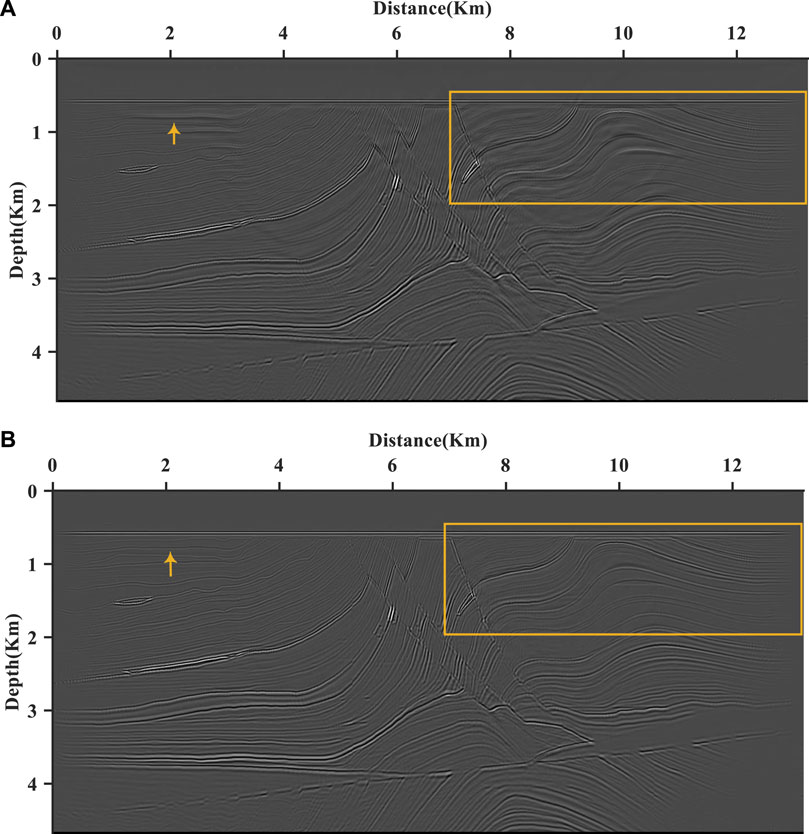
FIGURE 15. The PP images of the Marmousi 2 model by the scalar imaging condition with the Laplace filter (A) and with the pseudo-Laplace filter (B). The two images embody the structural characteristics of the model. The overall appearance of Panel B is more apparent and events in the shallow layer are more continuous than those in Panel A. Furthermore, the backscattering noise of Panel A is more serious than that in Panel B.
We further extracted the traces from PP images with a Laplace filter (Figure 15A) and a pseudo-Laplace filter (Figure 15B) at a depth of 1.32 km. As shown in Figure 16, we compare the amplitude of trace extracted from Figure 15A (blue curve) and Figure 15B (red curve) with the theoretical reflection coefficient
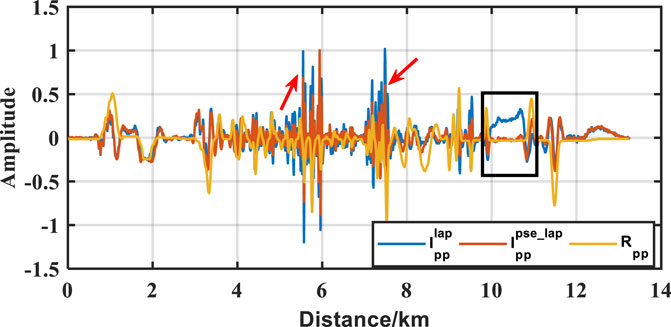
FIGURE 16. The comparison between normalized amplitudes of theoretical reflection coefficient
To observe clearly, we intercept the part of the Marmousi 2 model with a distance from 7–13 km and a depth from 0.5 to 4 km. Figures 17A,B are the partial enlargements of the P-wave velocity of the elastic Marmousi 2 model and S-wave velocity of the elastic Marmousi 2 model amplified, respectively. Correspondingly, Figure 18A is a partial enlargement of the PP image of the Marmousi 2 model by the scalar imaging condition with a Laplace filter (Figure 15A), and Figure 18B is a partial enlargement of the PP image of the Marmousi 2 model by the scalar imaging condition with the pseudo-Laplace filter (Figure 15B). Even as the polarity reversal described by Figure 16, the phase of the stacked PP image with a Laplace filter is opposite to that of the stacked PP image with a pseudo-Laplace filter and is no longer continuous at the cover of the anticline. As marked by the blue curve, the phase of the event in Figure 18B is more persistent than in Figure 18A, especially at the cover of an anticline. Furthermore, there is an oil and gas reservoir at sub-cover with the variation of S-wave velocity in Figure 17B. The disturbance at sub-cover (marked by the red arrow) succeeds to be imaged in Figure 18A but fails to be imaged in Figure 18A. Overall, the scalar imaging condition with a pseudo-Laplace filter generates a high-quality PP image in complicated geological structures.
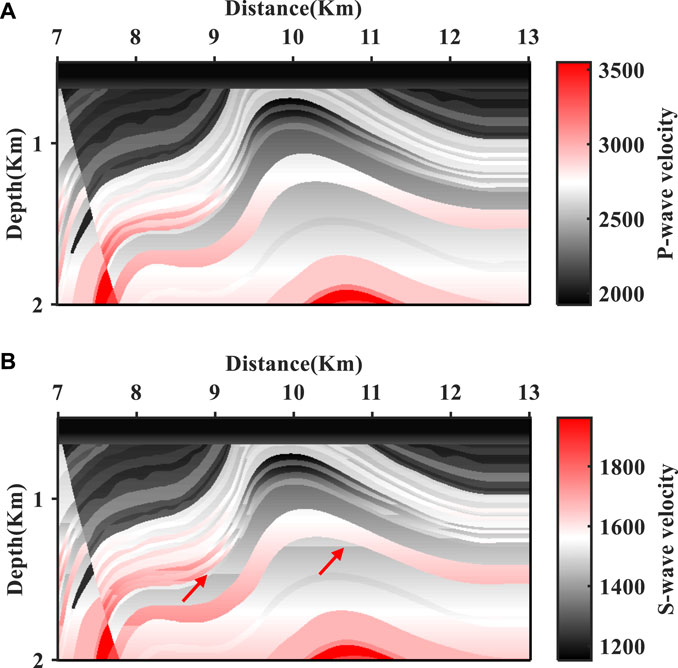
FIGURE 17. The partial enlargements of the P-wave velocity of the elastic Marmousi 2 model (A) and the S-wave velocity of the elastic Marmousi 2 model (B).
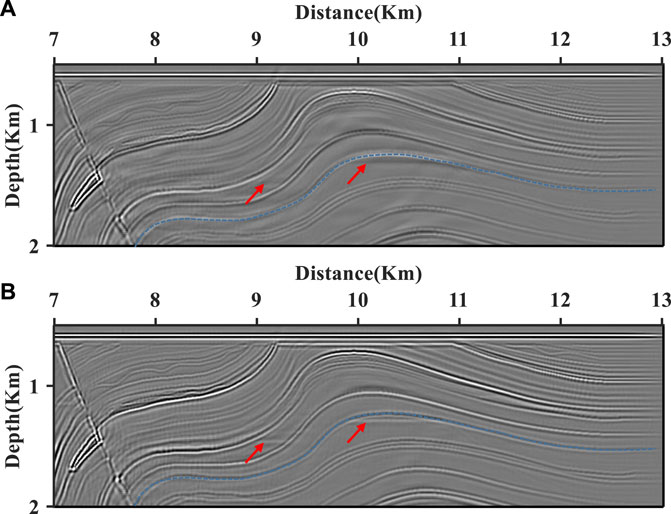
FIGURE 18. The partial enlargements of PP images of the Marmousi 2 model by the scalar imaging condition with the Laplace filter (Panel A) and with the pseudo-Laplace filter (Panel B). The polarity of the event (such as events marked by the blue curve) in Panel B is more continuous than that in Panel A. Furthermore, clearer interfaces and less disturbance of the oil and gas reservoirs at sub-cover (marked by the red arrow), indicated by the partial enlargements of the elastic Marmousi 2 model in Figure 17B, are located in Panel B.
Discussions
The dot product cross-correlation scalar imaging condition, similar to the cross-correlation scalar wave field imaging condition, is a simple and effective imaging condition for vector-based wavefields. Naturally, the PP image by the dot product scalar imaging condition encounters backscattering noise, also being in cross-correlation imaging results, and polarity reversal problem caused by the weighting factor
Table 1 is the comparative table for the Laplace filter and pseudo-Laplace filter characters from the backscattering noise, the polarity reversal, the spectral variation, and the computation cost. Overall, the pseudo-Laplace filter is similar to the Laplace filter in backscattering suppression, spectral variation, and computation cost. However, it is only the pseudo-Laplace filter that could correct the polarity reversal problem at large incidence. Therefore, the field data with large offset are suitable for the proposed pseudo-Laplace filter. As for the filters composed of second-order spatial derivatives, the angular frequency
Once the low-frequency information is compensated, the weighting factor
Conclusion
The PP image by the dot product–based scalar imaging condition will encounter the problem of polarity reversal when the opening angle exceeds
Data Availability Statement
The original contributions presented in the study are included in the article/Supplementary Material; further inquiries can be directed to the corresponding authors.
Author Contributions
QD and XZ contributed to the conception and design of the study. SZ organized the database and performed the statistical analysis. FZ and L-YF modified the manuscript. All authors contributed to manuscript revision and read and approved the submitted version.
Funding
This research was supported by the National Science Foundation of China (41930429 and 41774139), the China National “111” Foreign Experts Introduction Plan for Tight Oil & Gas Geology and Exploration, and the Deep-Ultradeep Oil & Gas Geophysical Exploration and Qingdao Applied Research Projects.
Conflict of Interest
The authors declare that the research was conducted in the absence of any commercial or financial relationships that could be construed as a potential conflict of interest.
Publisher’s Note
All claims expressed in this article are solely those of the authors and do not necessarily represent those of their affiliated organizations, or those of the publisher, the editors and the reviewers. Any product that may be evaluated in this article, or claim that may be made by its manufacturer, is not guaranteed or endorsed by the publisher.
Acknowledgments
The authors are grateful to the associate editor H-WZ and reviewers for reviewing this manuscript and Qamar Yasin for revising this manuscript.
References
Baysal, E., Kosloff, D. D., and Sherwood, J. W. C. (1983). Reverse Time Migration. Geophysics 48 (11), 1514–1524. doi:10.1190/1.1441434
Claerbout, J. F. (1971). Toward a Unified Theory of Reflector Mapping. Geophysics 36 (3), 467–481. doi:10.1190/1.1440185
Dellinger, J., and Etgen, J. (1990). Wave‐field Separation in Two‐Dimensional Anisotropic media. Geophysics 55 (7), 914–919. doi:10.1190/1.1442906
Du, Q., Gong, X., Zhang, M., Zhu, Y., and Fang, G. (2014). 3D PS-Wave Imaging With Elastic Reverse-Time Migration. Geophysics 79 (5), S173–S184. doi:10.1190/geo2013-0253.1
Du, Q., Guo, C., Zhao, Q., Gong, X., Wang, C., and Li, X.-y. (2017). Vector-based Elastic Reverse Time Migration Based on Scalar Imaging Condition. Geophysics 82 (2), S111–S127. doi:10.1190/geo2016-0146.1
Du, Q. Z., Zhu, Y. T., Zhang, M. Q., and Gong, X. F. (2013). A Study on the Strategy of Low Wavenumber Noise Suppression for Prestack Reverse Time Depth Migration. Chin. J. Geophys. 56 (7), 2391–2401. doi:10.6038/cjg20130725
Duan, Y., and Sava, P. (2015). Scalar Imaging Condition for Elastic Reverse Time Migration. Geophysics 80 (4), S127–S136. doi:10.1190/geo2014-0453.1
Elita Li, Y., Du, Y., Yang, J., Cheng, A., and Fang, X. (2018). Elastic Reverse Time Migration Using Acoustic Propagators. Geophysics 83 (5), S399–S408. doi:10.1190/geo2017-0687.1
Lecomte, I. (2008). Resolution and Illumination Analyses in Psdm: A ray-Based Approach. Leading Edge 27 (5), 650–663. doi:10.1190/1.2919584
Li, Z. C. (2007). Numeric Simulation of Elastic Wavefield Separation by Staggering Grid High-Order Finite-Difference Algorithm (In Chinese). Oil Geophys. Prospect. 42 (5), 510–515. doi:10.1016/S1872-5813(08)60001-8
Liu, H. W., Liu, H., Zou, Z., and Cui, Y. F. (2010). The Problem of Denoise and Storage in Seismic Reverse Time Migration (In Chinese): Chinese. J. Geophys. 53 (9), 2171–2180. doi:10.1002/cjg2.1530
Ma, D., and Zhu, G. (2003). Numerical Modeling of P-Wave and S-Wave Separation in Elastic Wavefield. Oil Geophys. Prospect. 38 (5), 482–486. doi:10.1007/BF02974893
Martin, G. S., Wiley, R., and Marfurt, K. J. (2006). Marmousi2: An Elastic Upgrade for Marmousi. The Leading Edge 25 (2), 156–166. doi:10.1190/1.2172306
McMechan, G. A. (1983). Migration by Extrapolation of Time-dependent Boundary Values*. Geophys. Prospect 31 (3), 413–420. doi:10.1111/j.1365-2478.1983.tb01060.x
Rocha, D., Tanushev, N., and Sava, P. (2016). Isotropic Elastic Wavefield Imaging Using the Energy Norm. Geophysics 81 (4), S207–S219. doi:10.1190/geo2015-0487.1
Sun, R., and McMechan, G. A. (1986). Pre-Stack Reverse-Time Migration for Elastic Waves With Application to Synthetic Offset Vertical Seismic Profiles. Proc. IEEE 74 (3), 457–465. doi:10.1109/PROC.1986.13486
Tang, C., and McMechan, G. A. (2018). Multidirectional-vector-based Elastic Reverse Time Migration and Angle-Domain Common-Image Gathers with Approximate Wavefield Decomposition of P- and S-Waves. Geophysics 83 (1), S57–S79. doi:10.1190/geo2017-0119.1
Wang, W., and McMechan, G. A. (2015). Vector-based Elastic Reverse Time Migration. Geophysics 80 (6), S245–S258. doi:10.1190/geo2014-0620.1
Whitmore, N. D. (1983). Iterative Depth Migration by Backward Time Propagation: SEG Technical Program Expanded Abstracts 1983. Soc. Expl. Geophys., 382–385.
Xiao, X., and Leaney, W. S. (2010). Local Vertical Seismic Profiling (VSP) Elastic Reverse-Time Migration and Migration Resolution: Salt-Flank Imaging with Transmitted P-To-S Waves. Geophysics 75 (2), S35–S49. doi:10.1190/1.3309460
Yan, J., and Sava, P. (2008). Isotropic Angle-Domain Elastic Reverse-Time Migration. Geophysics 73 (6), S229–S239. doi:10.1190/1.2981241
Yang, J., Zhu, H., Huang, J., and Li, Z. (2018). 2D Isotropic Elastic Gaussian-Beam Migration for Common-Shot Multicomponent Records. Geophysics 83 (2), S127–S140. doi:10.1190/geo2017-0078.1
Yoon, K., and Marfurt, K. J. (2006). Reverse-Time Migration Using the Poynting Vector. Geophys. Explor. 59 (1), 102–107.
Youn, O. K., and Zhou, H. W. (2001). Depth Imaging with Multiples. Geophysics 66 (1), 246–255. doi:10.1190/1.1444901
Zhou, X., Chang, X., Wang, Y., and Yao, Z. (2018). Scalar Pp and Ps Imaging of Elastic Rtm by Wavefield Decoupling Method: SEG Technical Program Expanded Abstracts 2018. Soc. Expl. Geophys., 2417–2421. doi:10.1190/segam2018-2995359.1
Zhu, H. (2017). Elastic Wavefield Separation Based on the Helmholtz Decomposition. Geophysics 82 (2), S173–S183. doi:10.1190/geo2016-0419.1
Appendix A: Hadamard Product and its Application
For the vectors s and t with the same dimension, we can obtain a new vector w by the Hadamard product ◦. The new vector
By introducing the Hadamard product into vectors
Keywords: elastic RTM, scalar imaging condition, backscattering suppression, polarity correction, pseudo-Laplace filter
Citation: Du Q, Zhang X, Zhang S, Zhang F and Fu L-Y (2021) The Pseudo-Laplace Filter for Vector-Based Elastic Reverse Time Migration. Front. Earth Sci. 9:687835. doi: 10.3389/feart.2021.687835
Received: 30 March 2021; Accepted: 21 June 2021;
Published: 13 August 2021.
Edited by:
Hua-Wei Zhou, University of Houston, United StatesReviewed by:
Aifei Bian, China University of Geosciences Wuhan, ChinaJidong Yang, China University of Petroleum (Huadong), China
Copyright © 2021 Du, Zhang, Zhang, Zhang and Fu. This is an open-access article distributed under the terms of the Creative Commons Attribution License (CC BY). The use, distribution or reproduction in other forums is permitted, provided the original author(s) and the copyright owner(s) are credited and that the original publication in this journal is cited, in accordance with accepted academic practice. No use, distribution or reproduction is permitted which does not comply with these terms.
*Correspondence: Qizhen Du, bXVsdGljb21wb25lbnRAMTYzLmNvbQ==; Xiaoyu Zhang, emh4eV91cGNAMTI2LmNvbQ==
 Qizhen Du
Qizhen Du Xiaoyu Zhang
Xiaoyu Zhang Shukui Zhang5
Shukui Zhang5 Fuyuan Zhang
Fuyuan Zhang Li-Yun Fu
Li-Yun Fu